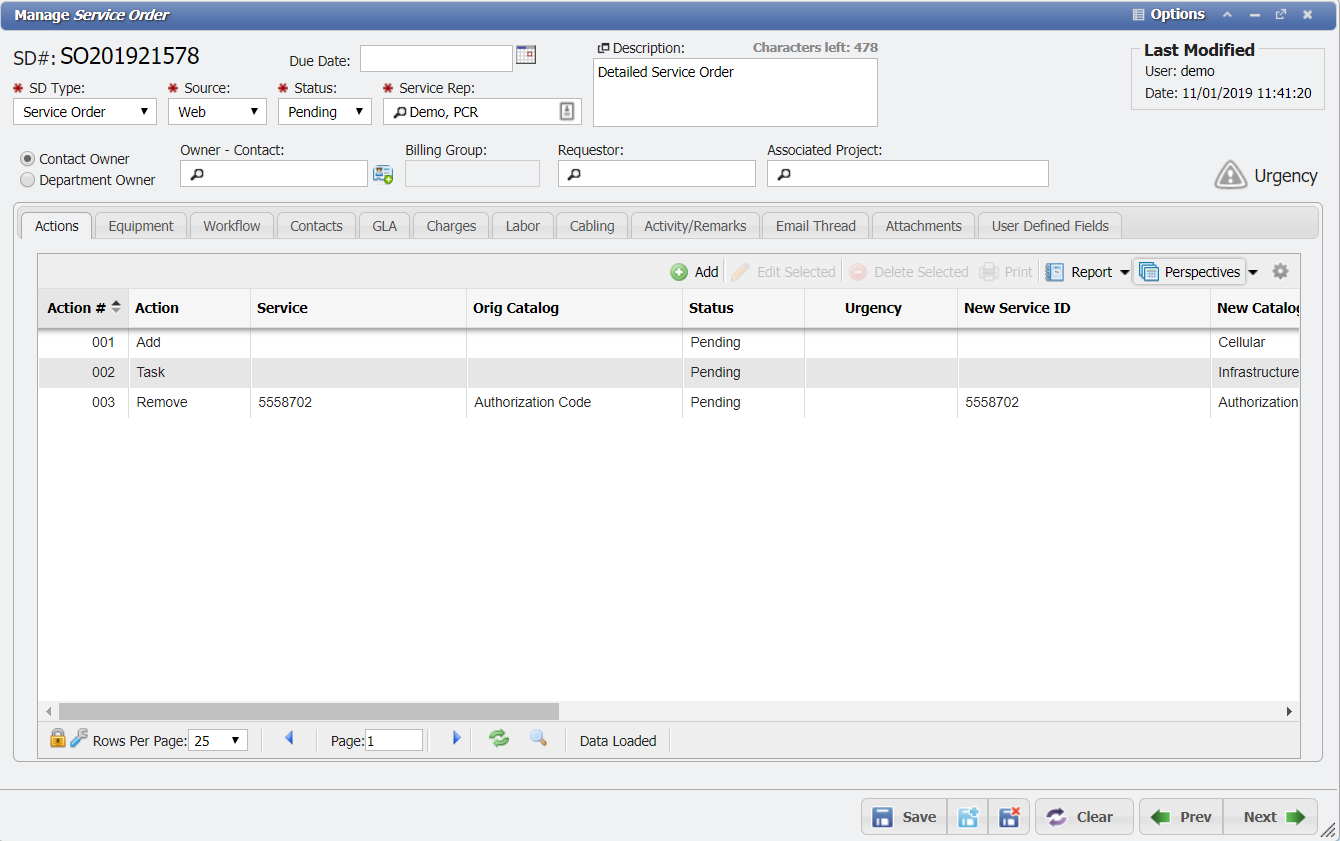Service Orders
Navigate to the Service Orders grid by clicking on the Service Desk icon under the 'Main' tab, then clicking on ‘Orders’. If a User has recently advanced a Service Request into a Service Order, that item will now be visible on the Service Order grid. Double-click on any item in the Service Orders grid to access the Service Order data entry form, as seen in below.
From the Main > Service Desk > Service Orders grid, a User is able to view the Assigned Workers, Completed Workers, Assigned Workgroups, and Completed Workgroups related to each item.

Service Order example
Now that the Service Request has become a 'Service Order', Users will need to interact with the set of tabs visible in the Service Order data entry form (see "Service Order Form" image above). Using the various tabs, Users may create Workflows, Add Actions, Equipment, Contacts, and Charges, etc. to the Service Order.
Required Fields
SD Type - This required input is automatically set and filled to 'Service Order' when a User creates a new Service Order, either by converting from a Request or using the
 button.
button. Source - This field will denote the original source of the Request or Service Order. System defaults are 'Web' and 'Email'. Additional List Values can be added by an Administrator to the Type 'SD_SOURCE'. For example, 'Phone', 'Tech', 'Quick Tick', 'Fax', 'Text', etc.
Status - The status of 'Service Order' which determines follow on actions.
Pending - The Pending Status is the initial status of any newly created Status.
Complete - When all Workflow is marked complete, the Service Order can be marked 'Complete'. Sets form inputs, Actions tab, Equipment tab, and Contacts tab to read only. Order is awaiting Finalization.
Finalized - Sets remaining tabs; Workflow, GLA, Charges, and Labor as read only. Charges are exported at this point.
Hold - Service Order is waiting for further action.
Void - Service Order has been determined to be invalid or no longer needed.
Service Rep - Assignment of the Service Representative who created or was assigned the Service Order.
Editing a Service Order
Data Entry Form – Tabs
In the image of the Service Order Form above, consider the tabs displayed immediately below the input fields in the data entry form. By accessing these tabs, users can initiate the process of fulfilling the Service Order by adding specific Workflow actions, applying billing procedures, and a number of other critical functions. The 'Tabs' associated with Service Orders are Actions, Equipment, Workflow, Contacts, GLA, Charges, Labor, Cabling, Activity/Remarks, Email Thread, Attachments, and User Defined Fields .
Completing a Service Order
The extent to which a Service Order's tabs and data input fields are utilized is ultimately up to the Service Order's Service Rep to determine. At any point in the Order process, a Service Rep or fellow User can change the Order's status from 'Pending' – the default status for a Request or Order currently in-process – to 'Complete', 'Hold', 'Void', or 'Denied'. When the Service Order is saved, even if an Order is deemed 'Complete', it will remain on the Service Order grid for further reference or potential re-visitation.
If a Service Order is deemed 'Complete', or anything other than 'Pending' for that matter, all parties, including the Requestor, Service Rep, or anyone listed under the Workflow, Action, or Contact/Owners tabs, will be notified of the status change automatically. The Service Order's completion will be reflected in relevant parties' My Service Desk and Dashboard portals.
When a Service Order or Action is completed, the Service itself is created and/or the Equipment is moved to its appropriate Location. At this point all Workflow must be complete. After completion, more Workflow, Charges and Labor can be added if necessary, but these must be completed before changing the Order status to 'Finalized'.
Finalizing a Service Order
When a Service Order or Action is Finalized, all Charges are moved from the Service Order to the Service and/or Equipment. Recurring Charges will have a start date based on the 'Finalized Date'. The 'Finalized' Status locks all fields and grids on the form and prepares the Order/Action to be Billed.
Once an Order is Finalized it is ready to be Billed.
If there are no Charges actually attached to the Service Order then the Status will stay finalized. There actually has to be Charges Billed to the Order not just ones from the Service. If there are no NRCs on the Order/Actions then there was nothing to Bill so it will not set the Status to Billed.
If there are NRC Charges, then the next time a Bill is generated any Finalized Orders will be included in that Bill. The Order's Status is automatically updated to 'Billed'. This represents the final status for most Orders.
Note: Once a Service Desk Item's Status is set to "Complete" or "Finalized", PCR cannot and will not roll back this action. PCR can roll back the database as an extreme measure, but this should be thought of as a last resort. Think of this process like baking a cake. Once all of the ingredients are mixed in, and you bake the cake, when you pull the cake out of the oven, you can't go back and remove the eggs from the cake.
Service Orders and Work Orders
Unlike Projects and Problems, Service Orders can not be associated with Work Orders. For "Work Orders" to be associated with a Service Order, rather than create a Work Order, create a Task Action on the Service Order to represent that Work Order.
